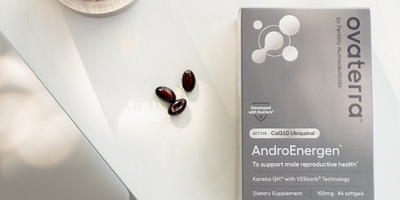Ovulation is the process in which a mature egg is released from the ovaries and into the fallopian tube. This is a crucial process for conception. After ovulation, the egg remains alive in the fallopian tube for about 12 to 24 hours.
For conception to happen, there must be sperm waiting to fertilize the egg in the fallopian tube in these 12-24 hours. Without ovulation, there would be no egg to fertilize, and a baby would not be conceived. Let’s dig deeper into what ovulation is, the best testing methods, and signs to watch for.
When does ovulation happen?
The rule of thumb is that ovulation happens right in the middle of your cycle. So, in an average 28-day menstrual cycle, ovulation occurs approximately 14 days before your next period begins.
This is on average, however; studies have shown that the timing of ovulation varies from woman to woman, making it important to track your menstrual cycles to learn more about your own body’s schedule.
The lengths of menstrual cycles also vary, although the average length is 28-32 days. You can use a calendar to track the first and last days of your period to better understand your potential time of ovulation and know what the signs of ovulation are.
Let’s go over this simple breakdown of ovulation.
- Luteinizing hormone (LH) levels rise just before ovulation. LH triggers the release of the egg from the ovary.
- Usually, one egg is released from an ovarian follicle each month during ovulation.
- The egg travels down the fallopian tubes to the uterus to be fertilized.
- An ovulated egg can survive up to 24 hours, while sperm can last up to five days.
- Implantation doesn’t take place until six to 12 days after the egg has been fertilized.
- If the egg does not meet with a sperm, it will die off and be absorbed into the uterine lining.
How can I tell when I’m ovulating?
Some women know it just by “listening to the body.” An easier way to tell if you are close to ovulating is to take at-home ovulation tests. Ovulation tests can also help you estimate when you are most fertile during your menstrual cycle.
Ovulation predictor kits can be used to detect an increase in your luteinizing hormone (LH) levels. These testing kits usually come with a handful of test strips, so you can start testing about 11 days in, if you have a 28-day cycle.
Important: Your first day is the start of your period. The beginning of your period should be the first day you have a complete flow, not just spotting.
The test works similarly to a pregnancy test. You pee on a testing strip, which detects luteinizing hormone in your urine. If your test result is positive, ovulation is likely to occur in the next 24 to 36 hours.
Hormone-based ovulation kits can be difficult to interpret for women with conditions like PCOS, women over 40 and women with irregular periods. To figure out what kind of ovulation tracker works best for you, check out our ovulation tracker selection guide.
What are common signs and ovulation symptoms?
As your body goes through some changes before and during ovulation. Many women have signs or symptoms that give them a clue that they are ovulating, without taking an ovulation test.
The most common signs if you are ovulating or about to ovulate include:
- Breast tenderness
- Slight cramping, bloating, or an ache in your lower abdomen
- An increase in sex drive
- Heightened senses like smell and taste
- Light spotting
- Change in cervical mucus: Your vaginal secretions become clear and watery when your body is preparing to ovulate. The look and consistency are similar to raw egg whites. After ovulation, vaginal secretions may be more cloudy and thicker. If you keep an eye out for these changes, with practice, you can know exactly when ovulation is occurring.
- Change in basal body temperature: Your basal body temperature, or BBT, is your resting temperature. During ovulation, basal body temperature is increased slightly and can be an indicator of ovulation. You can measure your basal body temperature at home, with a BBT thermometer.
Not everyone will experience these signs and symptoms during ovulation, but if you do notice these changes in your body, it’s a good idea to keep track of them. Many ovulation tracking apps and kits have an area where you can log these changes to better understand your cycles.
How to track ovulation symptoms
Whether you are using an app or a handwritten journal, here are some ways you can keep track of your ovulation symptoms:
- Record your period’s start and end dates with an app or notebook, which can be especially helpful if you have irregular periods.
- Record what your menstruation is like (heavy or light).
- Note your basal body temperature (BBT) or cervical mucus, if you are tracking these.
- Make a note of changes in your body (like bloating, mood, cramps, sex drive and so on).
While simple ovulation test kits don’t come with a dedicated app to track symptoms or cycles, many ovulation trackers come with an app to do so. (All of the 4 ovulation trackers our scientific team recommends come with handy apps.) Having all the information about your ovulation in one place can be a great way to be more familiar with your own cycle patterns.
How long does ovulation last?
Ovulation lasts for up to 24 hours. While sperm can wait for an egg in the fallopian tube for 4-5 days, an ovulated egg can survive for just 24 hours, making it important to know when ovulation occurs if you are trying to conceive.
Because of the sperm’s longer survival period, your fertile window is 4-5 days, leading up to ovulation. You have the best chance of pregnancy when sperm is already in the fallopian tube when ovulation occurs.
When is the best time to have intercourse?
When you see an increase in the luteinizing hormone in a positive ovulation test, you know ovulation is coming within 12-36 hours. That means you should have unprotected intercourse within that time frame. As you test ovulation over several cycles, you are likely to get better attuned to your cycles, and may be able to estimate your fertile window a few days further back, which will give you a few more days to try.
Testing methods for ovulation
Basal body temperature tests
Basal body temperature “tests” is a bit of a misnomer, as your BBT needs to be monitored throughout your menstrual cycle, not just when you think you are close to ovulating. Nonetheless, BBT is a good tool to know when you are close to ovulation.
BBT tracking is done by recording your temperature daily, as soon as you wake up - and before doing anything else. (Or you can wear Tempdrop, an app-enabled BBT sensor to bed and not worry about getting up at the same time every day.) When you notice a slight dip in your BBT, followed by an increase, this is a signal that you are close to ovulating and ready for conception.
The BBT test can also be used to detect early pregnancy. If your BBT remains elevated for 18 days after ovulation, there’s a good chance you are pregnant.
Note: There may be other reasons your body temperature rises, so using more than your BBT to detect ovulation is an excellent way to know where you stand.
Ovulation detection test
If you have been trying for a few months and haven’t found success, using an ovulation detection test is another way to pinpoint exactly when your body is ready to get pregnant.
Specifics can vary, but many ovulation detection kits measure the amount of LH in your urine. Others measure follicle-stimulating hormone (FSH), progesterone or estradiol. In the case of LH, the hormone is always present in your urine. However, levels increase one to two days before ovulation.
When should you use an ovulation tracking kit?
Ovulation detection tests are typically recommended to be done in the morning, so that your urine is at its highest concentration. These tests have about a 99% accuracy rate, in terms of detecting the changes in the hormone levels, though interpreting the faint lines can take some getting used to.
Tip: These ovulation tests are meant to be taken for several days until you receive a positive test result, but how do you know when to start testing for ovulation? You can use the changes in your cervical mucus to guide you: When your mucus is similar to egg whites in consistency, that’s when you may want to start testing. (More on this below.)
Cervical mucus tracking
Another way to know when you ovulate is to pay attention to the changes in your cervical mucus. To do this, you observe your vaginal secretions throughout your cycle and record what you see.
Because our cervical mucus changes in consistency before and after ovulation, you can detect when ovulation occurs without taking tests. Just before ovulation, your cervical mucus is usually thin and watery, like raw egg whites - to facilitate sperm’s movement toward the egg - while it tends to be thicker and stickier, or nonexistent, the rest of your cycle.
A study showed that the cervical mucus-based method could be effective for about 90 percent of women within three months. This method can also be inexpensive, as it doesn’t necessarily require a device or test strips.
An advanced cervical mucus tracker, called kegg, helps detect changes in the vaginal mucus by detecting the changes in the composition of cervical mucus. kegg’s algorithm analyzes your results and helps you detect ovulation without a lot of guesswork.
Bonus: kegg can help you strengthen your pelvic floor, too, if you use it to do kegel exercises.
When to ask your doctor
Looping in your women’s health doctor or OBGYN in your preconception plans is essential. They can help guide you before, during, and after pregnancy.
If you have been trying to conceive for a year without success, you should bring up ovulation testing and other conception efforts to your doctor. For women 35 and above, you should act sooner, after six months of having unprotected sex without a pregnancy.
When you have data - your ovulation test results and records of your ovulation symptoms, among others - you can have a more in-depth conversation with your doctor. This data, combined with the results of other fertility tests that they’ll likely order, will help your doctor evaluate your situation and come up with a plan to discuss with you.
The bottom line
Ovulation is one of the most important processes your body goes through to reproduce. You can know if you are ovulating, and when that’s likely to happen, by using ovulation test strips, a BBT thermometer or the cervical mucus method. Knowing your fertile days and your day of ovulation will help increase your chance of getting pregnant.
If you are having difficulty getting pregnant, talk to your healthcare provider about what you should do to track your ovulation. If we can answer any questions or help you find the right ovulation tracker for you, please reach out. We are with you.












